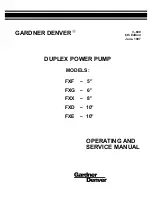
English |
23
Starting Operation
Preselecting the speed
You can preselect the required speed using the speed
preselection thumbwheel
(15)
, even during operation.
1−2
low speed
3−4
medium speed
5−6
high speed
The values shown in the table are guide values. The required
speed is dependent on the material and the work conditions
and can be determined by practical trials.
Material
Router bit
diameter [mm]
Thumbwheel
position
Hardwood (beech)
4–10
12–20
22–40
5–6
3–4
1–2
Softwood (pine)
4–10
12–20
22–40
5–6
3–6
1–3
Chipboard
4–10
12–20
22–40
3–6
2–4
1–3
Plastics
4–15
16–40
2–3
1–2
Aluminium
4–15
16–40
1–2
1
After working at a low speed for an extended period, you
should operate the power tool at the maximum speed for ap-
proximately three minutes without load to cool it down.
Switching on/off
Before switching on, set the required routing depth.
To
switch on
the power tool, press the on/off switch
(20)
and keep it pressed.
Press the lock-on button
(19)
to
lock
the on/off switch
(20)
in this position.
To
switch off
the power tool, release the on/off switch
(20)
;
or, if the switch is locked with the lock-on button
(19)
,
briefly press the on/off switch
(20)
and then release it.
Constant electronic control
The Constant Electronic keeps the speed at no load and un-
der load virtually consistent, guaranteeing uniform perform-
ance.
Soft start
The electronic soft start limits the torque when the power
tool is switched on and increases the service life of the mo-
tor.
Setting the routing depth
u
The routing depth must only be set while the power
tool is switched off.
Setting the routing depth on the plunge base
(see figure G)
To set the rough routing depth, proceed as follows:
– Place the power tool with a fitted router bit onto the work-
piece you want to machine.
– Set the scale for fine adjustment
(6)
to
0
.
– Set the turret stop
(12)
to the lowest setting; you will feel
the turret stop engage.
– Loosen the knurled screw on the depth stop
(16)
so that
the depth stop
(11)
moves freely.
– Press down the release lever for the plunge action
(7)
and
slowly guide the router down until the router bit
(18)
touches the workpiece surface. Let go of the release
lever
(7)
again in order to lock the plunging depth.
– Push the depth stop
(11)
down until it sits against the tur-
ret stop
(12)
. Set the slide with the index mark
(10)
to
position
0
on the routing depth scale
(9)
.
– Set the depth stop
(11)
to the required routing depth and
tighten the knurled screw
(16)
for the depth stop. Ensure
that you do not adjust the slide with the index mark
(10)
again by mistake.
– Press the release lever for plunge action
(7)
and guide the
router to the uppermost position.
The set routing depth is only reached when the depth
stop
(11)
touches the turret stop
(12)
while plunging.
For larger routing depths, you should perform the cut in sev-
eral phases, so that only a small amount of material is re-
moved after each cut. By using the turret stop
(12)
, the cut-
ting process can be divided into several steps. For this, ad-
just the desired depth of cut to the lowest step of the turret
stop and select the higher steps first for the initial cuts. The
clearance of the steps is approx. 3.2 mm.
After making a test cut, you can set the routing depth to the
exact level you require by turning the knob
(5)
. Turning it
clockwise increases the routing depth; turning it anticlock-
wise decreases the routing depth. The scale
(6)
can be used
for guidance. One revolution corresponds to an adjustment
range of 1.5 mm. Each of the graduation marks on the upper
edge of the scale
(6)
changes the adjustment range by
0.1 mm. The maximum adjustment range is ±16 mm.
Example:
The required routing depth should be 10.0 mm,
and the test cut resulted in a routing depth of 9.6 mm.
– Press the release lever for plunge action
(7)
and guide the
router to the uppermost position.
– Turn the adjustment knob
(5)
clockwise by
0.4 mm/4 graduation marks (difference from nominal to
actual value).
– Check the selected routing depth by performing another
test cut.
When fine-adjusting the routing depth, ensure that the index
mark
(8)
on the side of the plunge base points towards the
centre imprinted line. This measure ensures that there is suf-
ficient travel in both directions for readjustment of the
plunge depth.
Bosch Power Tools
1 609 92A 57S | (16.04.2021)
Содержание GKF 1600 CE Professional
Страница 3: ... 3 GOF 1600 CE GKF 1600 CE 1 2 3 4 4 Bosch Power Tools 1 609 92A 57S 16 04 2021 ...
Страница 5: ... 5 GKF 1600 CE 19 20 24 21 22 25 23 Bosch Power Tools 1 609 92A 57S 16 04 2021 ...
Страница 9: ... 9 2 54 55 14 14 55 54 3 3 24 56 57 58 58 59 R S T U Bosch Power Tools 1 609 92A 57S 16 04 2021 ...
Страница 276: ...276 1 609 92A 57S 16 04 2021 Bosch Power Tools ...
















































